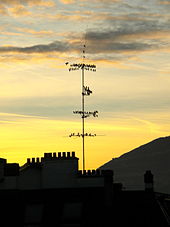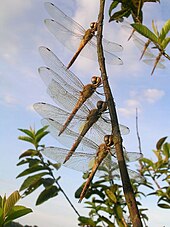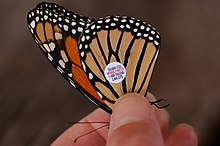Animal migration is the relatively long-distance movement of individuals, usually on a seasonal basis. It is found in all major animal groups, including birds, mammals, fish, reptiles, amphibians, insects, and crustaceans. The trigger for the migration may be local climate, local availability of food, the season of the year or for mating reasons. To be counted as a true migration, and not just a local dispersal or irruption the movement of the animals should be an annual or seasonal occurrence, such as Northern hemisphere birds migrating south for the winter; wildebeest migrating annually for seasonal grazing; or a major habitat change as part of their life, such as young Atlantic salmon leaving the river of their birth when they have reached a few inches in size.
Overview


In Bird
Approximately 1,800 of the world's 10,000 bird species migrate long distances each year in response to the seasons. Many of these migrations are north-south, with species feeding and breeding in high northern latitudes in the summer, and moving some hundreds of kilometres south for the winter. Some species extend this strategy to migrate annually between the Northern and Southern Hemispheres. The Arctic tern is famous for its migration; it flies from its Arctic breeding grounds to the Antarctic and back again each year, a distance of at least 19,000 km (12,000 mi), giving it two summers every year. The average arctic tern will travel the equivalent of going around the Earth 60 times in their lifetime.
In Fish


Before the phenomenon of animal migration was understood, various folklore and erroneous explanations sprang up to account for the disappearance or sudden arrival of birds in an area. In Ancient Greece, Aristotle proposed that robins turned into redstarts when summer arrived. The barnacle goose was explained in European Medieval bestiaries and manuscripts as either growing like fruit on trees, or developing from goose barnacles on pieces of driftwood. Another example is the swallow, which was once thought, even by naturalists such as Gilbert White, to hibernate either underwater, buried in muddy riverbanks, or in hollow trees.
References
In General
In Specific Groups
For Children
External Links
Overview

A Christmas Island red crab on its migration.
Migration can take very different forms in different species, and as such there is no simple accepted definition of migration. One of the most commonly used definitions, proposed by Kennedy is
Migration encompasses four related concepts: persistent straight movement; relocation of an individual on a greater scale (both spatially and temporally) than its normal daily activities; seasonal ‘to-and-fro’ movement of a population between two areas; and movement leading to the redistribution of individuals within a population. Migration can be either obligate, meaning individuals must migrate, or facultative, meaning individuals can "choose" to migrate or not. Within a migratory species or even within a single population, often not all individuals migrate. Complete migration is when all individuals migrate, partial migration is when some individuals migrate while others do not, and differential migration is when the difference between migratory and non-migratory individuals is based on age or sex (for example).
The three main types of migration are pilotage, compass orientation, and true navigation.
While most migratory movements occur on an annual cycle, some daily movements are also referred to as migration. Many aquatic animals make a Diel vertical migration, travelling a few hundred metres up and down the water column, while some jellyfish make daily horizontal migrations, traveling a few hundred metres across a lake.
Irregular (non-cyclical) migrations such as irruptions can occur under pressure of famine, overpopulation of a locality, or some more obscure influence.
In Specific Group
Flocks of birds assembling before migration southwards.
Different kinds of animal migrate in different ways.In Bird
Approximately 1,800 of the world's 10,000 bird species migrate long distances each year in response to the seasons. Many of these migrations are north-south, with species feeding and breeding in high northern latitudes in the summer, and moving some hundreds of kilometres south for the winter. Some species extend this strategy to migrate annually between the Northern and Southern Hemispheres. The Arctic tern is famous for its migration; it flies from its Arctic breeding grounds to the Antarctic and back again each year, a distance of at least 19,000 km (12,000 mi), giving it two summers every year. The average arctic tern will travel the equivalent of going around the Earth 60 times in their lifetime.
In Fish

Many species of salmon migrate up rivers to spawn.
Most fish species are relatively limited in their movements, remaining in a single geographical area and making short migrations for wintering, to spawn, or to feed. A few hundred species migrate long distances, in some cases of thousands of kilometres. About 120 species of fish, including several species of salmon, migrate between saltwater and freshwater (they are 'diadromous').
Forage fish such as herring and capelin migrate around substantial parts of the North Atlantic ocean. The capelin for example spawn around the southern and western coasts of Iceland; their larvae drift clockwise around Iceland, while the fish swim northwards towards Jan Mayen island to feed, and return to Iceland parallel with Greenland's east coast.
In the 'sardine run' billions of Southern African pilchard Sardinops sagax spawn in the cool waters of the Agulhas Bank and move northward along the east coast of South Africa between May and July.
In Insects
An aggregation of migratory Pantala flavescens dragonflies, known as globe skimmers, in Coorg, India
Some winged insects such as locusts and certain butterflies and dragonflies with strong flight migrate long distances. Among the dragonflies, species of Libellula and Sympetrum are known for mass migration, while Pantala flavescens,known as the globe skimmer or wandering glider dragonfly, makes the longest ocean crossing of any insect, between India and Africa. Exceptionally, swarms of the desert locust, Schistocerca gregaria, flew westwards across the Atlantic ocean for 4500 km during October 1988, using air currents in the Inter-Tropical Convergence Zone.
In some migratory butterflies, such as the monarch butterfly and the painted lady, no individual completes the whole migration. Instead the butterflies mate and reproduce on the journey, and successive generations travel the next stage of the migration.
In Other Animals
Mass migration occurs in mammals such as the Serengeti 'great migration', an annual circular pattern of movement with some 1.7 million wildebeest and hundreds of thousands of other large game animals including gazelles and zebra.
Wildebeest on the Serengeti 'great migration'
Migration is important in other mammals including Cetaceans, the whales, dolphins and porpoises. Long-distance migrations occur in some bats, notably the mass migration of the Mexican free-tailed bat between Oregon and southern Mexico.
Some reptiles and amphibians migrate.
Some crustaceans migrate, most spectacularly the Christmas Island red crab which moves en masse each year by the million.
Tracking Migrations
Scientists gather observations of animal migration by tracking their movements. Animals were traditionally tracked with identification tags such as bird rings for later recovery; no information was obtained about the actual route followed between release and recovery, and only a small fraction of tagged individuals were generally recovered. More convenient, therefore, are electronic devices such as radio tracking collars which can be followed by radio, whether handheld, in a vehicle or aircraft, or by satellite. Tags can include a GPS receiver, enabling accurate positions to be broadcast at regular intervals, but these are inevitably heavier and more expensive than devices without GPS. An alternative is the Argos Doppler tag, also called a 'Platform Transmitter Terminal' (PTT) which sends regularly to the polar-orbiting Argos satellites; using Doppler shift, the animal's location can be estimated, relatively roughly compared to GPS, but at lower cost and weight.
A migratory butterfly, a monarch, tagged for identification
Radio tracking tags can be fitted to insects including dragonflies and bees.
In CultureBefore the phenomenon of animal migration was understood, various folklore and erroneous explanations sprang up to account for the disappearance or sudden arrival of birds in an area. In Ancient Greece, Aristotle proposed that robins turned into redstarts when summer arrived. The barnacle goose was explained in European Medieval bestiaries and manuscripts as either growing like fruit on trees, or developing from goose barnacles on pieces of driftwood. Another example is the swallow, which was once thought, even by naturalists such as Gilbert White, to hibernate either underwater, buried in muddy riverbanks, or in hollow trees.
References
- ^ a b c Hugh Dingle and V. Alistair Drake (2007). "What is migration?". BioScience 57 (2): 113–121. doi:10.1641/B570206.
- ^ National Geographic. Why Animals Migrate.
- ^ Attenborough, David (1990). The Trials of Life. London: Collins/BBCBooks. p. 123. ISBN 0-00-219940-8.
- ^ Kennedy, J. S. (1985). "Migration: Behavioral and ecological". In M., Rankin. Migration: Mechanisms and Adaptive Significance: Contributions in Marine Science. Marine Science Institute. pp. 5–26.
- ^ McLaren, I.A. (1974). "Demographic strategy of vertical migration by a marine copepod.". The American Naturalist 108 (959): 91–102. doi:10.1086/282887 JSTOR 2459738.
- ^ Hamner, W.M.; Hauri, I.R. (1981). "Long-distance horizontal migrations of zooplankton (Scyphomedusae: Mastigias).". Limnology and Oceanography 26 (3): 414–423. doi:10.4319/lo.1981.26.3.0414.
- ^
 Ernest Ingersoll (1920). "Migration". In Rines, George Edwin. Encyclopedia Americana.
Ernest Ingersoll (1920). "Migration". In Rines, George Edwin. Encyclopedia Americana. - ^ Sekercioglu, C.H. (2007). "Conservation ecology: area trumps mobility in fragment bird extinctions". Current Biology 17 (8): 283–286. doi:10.1016/j.cub.2007.02.019. PMID 17437705.
- ^ Peter Berthold, Hans-Günther Bauer, Valerie Westhead (2001). Bird Migration: A General Survey. Oxford: Oxford University Press. ISBN 0-19-850787-9.
- ^ Cramp, S., ed. (1985). Birds of the Western Palearctic. pp. 87–100. ISBN 0-19-857507-6.
- ^ Harden Jones, F. R. Fish Migration: strategy and tactics. pp139–166 in Aidley, 1981.
- ^ Myers, George S. (1949). "Usage of Anadromous, Catadromous and allied terms for migratory fishes". Copeia 1949 (2): 89–97. doi:10.2307/1438482.
In General
- Aidley, D.J. (1981) Animal migration, Cambridge University Press.
- Baker, R.R. (1978) The Evolutionary Ecology of Animal Migration. Holmes & Meier Publishers.
- Dingle, H. (1996) Migration: The Biology of Life on the Move. Oxford University Press.
- Gauthreaux, S.A. (1980) Animal Migration, Orientation, and Navigation. Academic Press.
- Milner-Gulland, E.J., J.M. Fryxell, and A.R.E. Sinclair (2011) Animal Migration: A Synthesis. Oxford University Press.
- Rankin, M. (1985) Migration: Mechanisms and Adaptive Significance: Contributions in Marine Science. Marine Science Institute.
- Riede, K. (2002) Global Register of Migratory Species. With database and GIS maps on CD.
- Alerstam, T. (1990) Bird migration. Cambridge University Press.
- Berthold, P. (2003) Avian migration. Springer.
- Drake, V.A. and Gatehouse, A. G. (1995) Insect migration: tracking resources through space and time. Cambridge University Press.
- Elphick, J. (1995) The atlas of bird migration: tracing the great journeys of the world's birds. Random House.
- Greenberg, R. and Marra, P.P. (2005) Birds of Two Worlds: The Ecology and Evolution of Migration. Johns Hopkins University Press.
- Harden Jones, F.R. (1968) Fish migration. St. Martin’s Press.
- Lucas, M.C. and Baras, E. (2001) Migration of freshwater fishes. Blackwell Science.
- McKeown, B.A. (1984) Fish migration. Timber Press.
- Gans, R. and Mirocha, P. How do Birds Find their Way? HarperCollins. (Stage 2)
- Marsh, L. (2010) Amazing Animal Journeys. National Geographic Society. (Level 3)
- http://www.nps.gov/akso/parkwise/Students/ReferenceLibrary/general/MigrationBasics.htm
- Witnessing the Great Migration in Serengeti and Masai Mara
- Global Register of Migratory Species-identifies, maps and features 4,300 migratory vertebrate species
- Animal migration on PubMed, MeSH term F01.145.113.083.
- Wikipedia







No comments:
Post a Comment